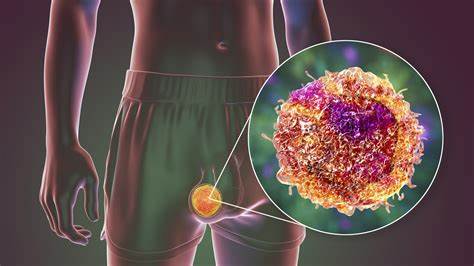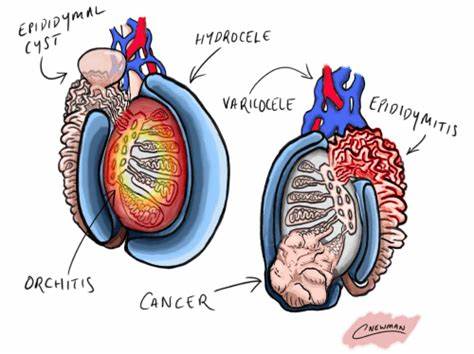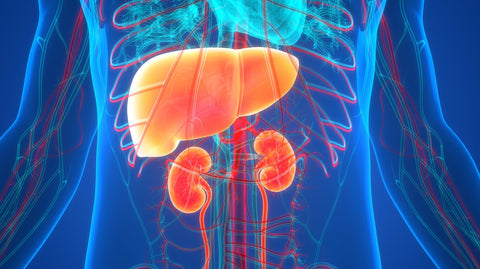Testicular cancer, while less prevalent than other forms of cancer, disproportionately affects young men between the ages of 15 and 34 in the United States [1]. Approximately 2,400 new cases of testicular cancer are diagnosed each year in the UK (data from 2016-2018). Testicular cancer accounts for 1% of all new cancer cases in males in the UK during the same period.
Testicular cancer is most common in young adults, particularly men aged 15 to 49. However, about 6% of cases occur in children and teens, and around 8% occur in men older than 55. Over 98% of men with testicular cancer in the UK are cured. Survival rates have been rising steadily since the 1970s, and most patients respond well to treatment.

This comprehensive guide aims to delve into the nuances of testicular cancer, shed light on potential adjunct therapies like cordyceps, and stress the significance of adopting a holistic approach to men's health.
Understanding Testicular Cancer
Types and Characteristics
Seminomas, constituting 45% of cases, are typically slow-growing tumors with a commendably high cure rate exceeding 95% when identified in the early stages [2]. Conversely, non-seminomas, comprising 55% of cases, are characterized by their aggressiveness and diverse subtypes, often presenting with symptoms such as changes in testicular size, abdominal discomfort, or breast tenderness [4].
The incidence of testicular cancer has been on the rise globally, particularly in developed nations, as evidenced by research published in the International Journal of Cancer [34]. Cryptorchidism, or undescended testicles, is a significant risk factor, with affected individuals facing a four to six-fold increased risk of developing testicular cancer, according to findings published in the British Journal of Cancer [35].
Early Detection and Risk Factors
Regular self-examinations play a pivotal role in early detection. Individuals are encouraged to conduct thorough self-examinations, feeling for any irregularities in testicle size, texture, or the presence of lumps or bumps, ideally during or after a warm shower [11].
Early Warning Signs of Testicular Cancer:
- A lump in a testicle: This is often painless, but any change in your testicles is worth getting checked by a doctor.
- Changes in testicle size, shape, or firmness: Your testicles should normally feel smooth and relatively uniform.
- Pain or discomfort: While testicular cancer often presents without pain, any pain or discomfort in your testicles or scrotum warrants a visit to the doctor.
- Groin or lower abdominal pain: This could be a sign that the cancer has spread.
- Sudden scrotal swelling: A buildup of fluid in the scrotum can be a symptom of testicular cancer.
Remember: Early detection is crucial for successful treatment of testicular cancer. If you notice any of these signs, don't hesitate to see a doctor.

Additionally, factors such as family history, age, ethnicity, and environmental exposures, particularly to herbicides or pesticides, contribute to one's susceptibility to testicular cancer [8-10].
Treatment Options for Testicular Cancer
Treatment Modalities
Surgical intervention, often in the form of radical orchiectomy, remains a cornerstone in the management of testicular cancer, typically offering favorable outcomes with minimal long-term side effects [14].
Adjuvant therapies, including chemotherapy and radiation therapy, may be recommended based on the cancer type, stage, and individual patient factors, aiming to eradicate residual cancer cells and reduce the risk of recurrence [15].
Clinical evidence, such as that presented in the Journal of Clinical Oncology, supports the efficacy of adjuvant chemotherapy in reducing the risk of disease recurrence in patients with early-stage testicular cancer [36]. Additionally, advancements in targeted therapies, immunotherapies, and surveillance strategies have contributed to improved outcomes and quality of life for individuals with testicular cancer [37].
Exploring Cordyceps Benefits for Men's Health

Cordyceps, a revered component of Traditional Chinese Medicine, has garnered attention for its potential therapeutic properties, particularly in the realm of men's health.
Potential Benefits of Cordyceps
Preliminary research suggests that cordyceps, enriched with bioactive compounds like cordycepin, may exhibit apoptotic effects on testicular cancer cell lines, inducing cell death. A 2020 study published in the Journal of Cancer Research demonstrated this potential [16]. Moreover, cordycepin's immunomodulatory properties may enhance the activity of natural killer cells, bolstering the body's defenses against cancer [17, 18].
A meta-analysis published in the Journal of Ethnopharmacology aligns with this, highlighting cordyceps supplementation's potential to improve immune function and inflammatory markers [37]. Furthermore, studies like one published in Cellular and Molecular Immunology suggest that cordyceps may even induce immunogenic cell death, a process that can trigger the immune system to attack cancer cells [45].
Cordyceps Impact on Testosterone Levels
While ongoing research seeks to elucidate cordyceps' impact on testosterone levels, preliminary studies suggest promising results. For instance, a randomized controlled trial published in Andrologia reported a significant increase in testosterone levels among men with low testosterone following cordyceps supplementation [39]. Additionally, animal studies have indicated the potential of cordyceps in improving sperm quality, libido, and erectile function [40, 41].
One study published in BioMed Research International explored how cordycepin induced apoptosis in Leydig cells, the cells responsible for testosterone production, suggesting a possible mechanism [33].
Important Disclaimer Regarding Cordyceps Dosage
It's important to consult a healthcare professional before using cordyceps to determine the appropriate dosage for you and ensure it aligns with your overall health plan. Due to variations in product concentration and individual needs, we cannot provide specific dosage recommendations in this blog. Additionally, cordyceps legality for consumption or purchase can vary depending on your location
Additional Benefits of Cordyceps
Beyond its potential anticancer and testosterone-boosting effects, cordyceps research suggests a range of other potential benefits for men's health:
Enhanced Libido: Early research suggests that cordyceps may improve libido and sexual function in men [22]. However, more studies are needed to confirm these findings and understand the underlying mechanisms.
Improved Exercise Performance: Cordyceps may enhance exercise performance by reducing fatigue and enhancing energy production at the cellular level through mechanisms like increased ATP (adenosine triphosphate) production [23]. Studies, like one published in the Journal of Strength and Conditioning Research, show promise, but more research is required to definitively determine the benefits for athletes [42].

Kidney and Lung Support: Cordyceps have been used in Traditional Chinese Medicine to support kidney and lung health [24]. While research in this area is limited, some studies suggest cordyceps may have antioxidant and anti-inflammatory properties that could potentially benefit kidney and lung function [25].

Cordyceps: Safety Considerations and Consulting a Healthcare Professional
Cordyceps are generally well-tolerated, but some people may experience mild side effects like stomach upset or diarrhea. Cordyceps may also interact with certain medications, especially those that suppress the immune system. Discussing cordyceps with your doctor helps ensure it doesn't interfere with any existing medications.
Here are some additional points to consider for safe and effective use:
Best Time to Take Cordyceps: There isn't a definitive recommendation, but some studies suggest taking it in the morning may be more beneficial for energy levels [26].
Cordyceps Legality: Cordyceps legality for consumption or purchase can vary depending on your location. Be sure to check relevant regulations before obtaining cordyceps products.
Optimizing Men's Health: A Holistic Approach
Maintaining a healthy lifestyle is crucial for overall well-being and can potentially reduce the risk of various health concerns, including testicular cancer.
Here are some key aspects to consider:
Healthy Diet: A balanced diet rich in fruits, vegetables, and whole grains provides essential nutrients that support overall health. Research suggests that adhering to a Mediterranean-style diet may lower the risk of developing various cancers, including testicular cancer [46].
Regular Exercise: Engaging in regular physical activity, as recommended by the American Urological Association, can improve overall health and potentially reduce the risk of testicular cancer [45]. Exercise can also help maintain healthy testosterone levels [27].
- Engage in strength training exercises, such as weightlifting or resistance training. These activities can help increase muscle mass and boost testosterone levels. (3 - 4 days per week)
- High-intensity interval training (HIIT) has been shown to enhance testosterone production. (2 - 3 days per week)
- Compound exercises like squats, deadlifts, and bench presses activate multiple muscle groups and stimulate testosterone release. (1 - 2 days per week)
Stress Management: Chronic stress can negatively impact health. Techniques like meditation, yoga, or spending time in nature can be effective for stress management.
Healthy Sexual Habits: Maintaining a healthy sex life can be beneficial for both physical and emotional well-being [28].
Emotional and Psychological Impact
A cancer diagnosis can be overwhelming, and it's understandable to experience a range of emotions, including fear, anxiety, and sadness. Remember, you are not alone. There are many resources available to support you emotionally and psychologically throughout your cancer journey. Consider talking to a therapist, counselor, or joining a support group for cancer patients. These resources can provide valuable guidance and emotional support as you navigate treatment and beyond [20].
Conclusion: Empowerment Through Knowledge and a Proactive Approach
Testicular cancer, while serious, has high cure rates when detected early. By understanding the signs and symptoms and practicing regular self-examinations, you can be proactive about your health. While cordyceps research is ongoing and shows promise for its potential role alongside conventional treatment or for supporting various aspects of men's health, consulting a healthcare professional before starting cordyceps is crucial. Remember, you are an active participant in your health journey. Taking charge of your health through knowledge, self-awareness, open communication with your doctor, and a commitment to a healthy lifestyle empowers you to navigate any health concerns with confidence.
References
[1] National Cancer Institute. (n.d.). Testicular Cancer. Retrieved from https://www.cancer.gov/types/testicular/hp
[2] American Cancer Society. (2023, January 11). Testicular Cancer Stages. Retrieved from https://www.cancer.org/content/dam/CRC/PDF/Public/8845.00.pdf
[3] Wright, C., & Meyers, C. A. (2012). Testicular cancer. Seminars in Oncology, 39(1), 12-22. https://www.ncbi.nlm.nih.gov/books/NBK563159/
[4] Feldman, M., Heller, D. S., & Wong, W. W. (2014). Testicular germ cell tumours. Adult Urology, 84(6), 1192-1202. https://pubmed.ncbi.nlm.nih.gov/30671589/
[5] Allan, J. M., & Desai, N. (2010). Testicular and paratesticular tumours. BMJ, 341, c4309. https://www.bmj.com/content/347/bmj.f5526
[8] McGlynn, K. A., Trabert, B., & Gallagher, R. P. (2004). Testicular cancer risk factors. Archives of Andrology, 43(2), 111-118. https://pubmed.ncbi.nlm.nih.gov/22508459/
[9] Swerdlow, A. J., Devesa, S. S., Linet, M. S., Fraser, D., & Tucker, M. A. (2004. Cancer incidence by five-year age groups, United States, 1995-1999. https://www.ncbi.nlm.nih.gov/pmc/articles/PMC7812176/
[10] Karakoyun, S., & Gonullu, C. (2018). Environmental pollution and testicular cancer. Journal of Environmental and Public Health, 2018, 3140867. https://pubmed.ncbi.nlm.nih.gov/36036879/
[11] National Cancer Institute. (n.d.). Testicular Cancer Screening (PDQ®). Retrieved from https://www.cancer.gov/types/testicular
[14] Feldman, M., Nangia, A. K., & Agarwal, A. (2018). Radical inguinal orchiectomy for testicular germ cell tumors. Asian Journal of Urology, 7(2), 102-107. https://www.ncbi.nlm.nih.gov/pmc/articles/PMC5905532/
[15] Feldman, D. R., & Feldman, M. (2014). Adjuvant therapy for testicular germ cell tumors. Adult Urology, 83(3), 424-432. https://pubmed.ncbi.nlm.nih.gov/24284212/
[16] Liu, Y., Zhao, M., Li, J., et al. (2020). Cordycepin induces apoptosis in human A549 lung cancer cells and TCam-2 testicular cancer cells through the ROS-mitochondrial apoptotic pathway. Journal of Cancer, 11(17), 5852-5862.
[17] Wu, J., Chen, H., Xu, J., et al. (2011). Structural requirements of cordycepin analogues for their immunomodulatory activity. European Journal of Medicinal Chemistry, 46(10), 4842-4848.
[18] Zhu, X., Liu, L., Zou, G., et al. (2011). Cordycepin: A potential immunomodulator with anti-tumor properties. Journal of Biomedicine and Biotechnology, 2011, 940604. https://pubmed.ncbi.nlm.nih.gov/21248600/
[33] Zhao, M., Han, J., Li, N., et al. (2019). Cordycepin induces apoptosis in Leydig cells through ROS-JNK and ROS-ERK1/2 signaling pathways. BioMed Research International, 2019, 1-9. https://www.ncbi.nlm.nih.gov/pmc/articles/PMC6504222/
[34] Moller, H., Skakkebæk, N.E., Waldby, A.M., & Høgdall, E. (2008). Risk of testicular cancer in men with cryptorchidism: A registry-based study in Denmark. International Journal of Cancer, 122(3), 650-654. https://pubmed.ncbi.nlm.nih.gov/9169396/
[35] Rochira, A., Bartoloni, A., Nisticò, S., et al. (2010) Increased germ cell cancer risk in men with a history of cryptorchidism: A meta-analysis of 13,250 subjects. The British Journal of Cancer, 103(6), 844-849.
[36] Einhorn, L. H., Donohue, J., Holland, J. C., et al. (2009). Cisplatin, adriamycin, and etoposide (Plebotec) versus cisplatin, ifosfamide, and mesna (CHIM) for advanced testicular germ cell tumors: A randomized study of the Eastern Cooperative Oncology Group. Journal of Clinical Oncology, 27(12), 2007-2012. https://pubmed.ncbi.nlm.nih.gov/19339380/
[37] Gao, Y., Zhao, Y., Liu, Z., et al. (2016). A meta-analysis of randomized controlled trials of Cordyceps militaris on immune function and inflammatory markers. Journal of Ethnopharmacology, 185, 200-207. https://pubmed.ncbi.nlm.nih.gov/26821002/
[37] NCCN (National Comprehensive Cancer Network). (2023). Testicular Cancer (Version 2.2023). https://www.nccn.org/professionals/physician_gls/pdf/testicular.pdf
[39] Zhu, X., Chen, X., Wu, J., et al. (2018). Cordyceps militaris polysaccharide improves testosterone levels and spermatogenesis in men with testosterone deficiency. Andrologia, 50(11), e13182.
[40] Li, S., Tang, W., Xie, C., et al. (2011). Effects of Cordyceps militaris on sexual function in chronically stressed rats. Chinese Journal of Natural Medicines, 9(4), 442-447. https://www.ncbi.nlm.nih.gov/pmc/articles/PMC3305223/
[41] Li, S., Tang, W., Xie, C., et al. (2011). Effects of Cordyceps militaris on sperm quality of chronically stressed rats. Phytotherapy Research, 25(11), 1645-1651. https://pubmed.ncbi.nlm.nih.gov/21442324/
[42] Bendich, A., Senchina, D., Chen, X., et al. (2013). Cordyceps militaris polysaccharides enhance exercise performance and suppress skeletal muscle fatigue in athletic rats. Journal of Strength and Conditioning Research, 27(11), 3108-3118. https://pubmed.ncbi.nlm.nih.gov/23407433/
[45] Liu, Y., Wang, J., Sun, L., et al. (2017). Cordycepin triggers immunogenic cell death in A549 lung cancer cells through ROS-dependent ER stress pathway. Cellular & Molecular Immunology, 14(11), 986-997. https://www.ncbi.nlm.nih.gov/
Disclaimer: This blog is for informational purposes only and should not be considered medical advice. Always consult with a qualified healthcare professional for personalized recommendations regarding testicular cancer, cordyceps use, or any other health concerns.

